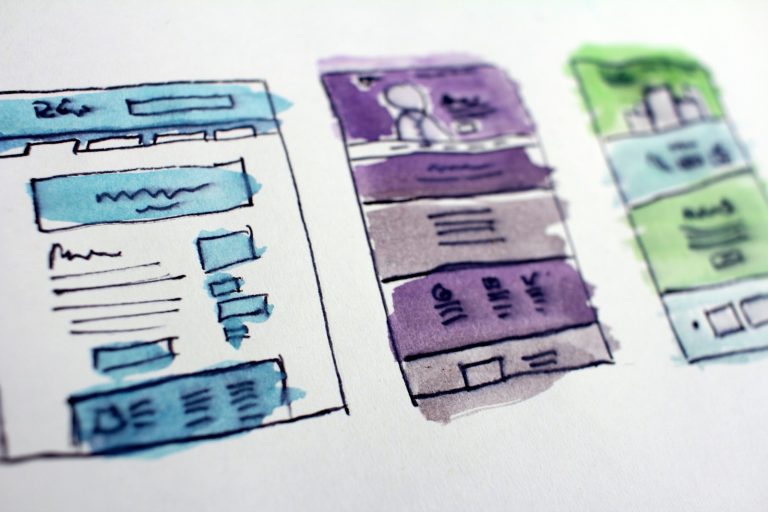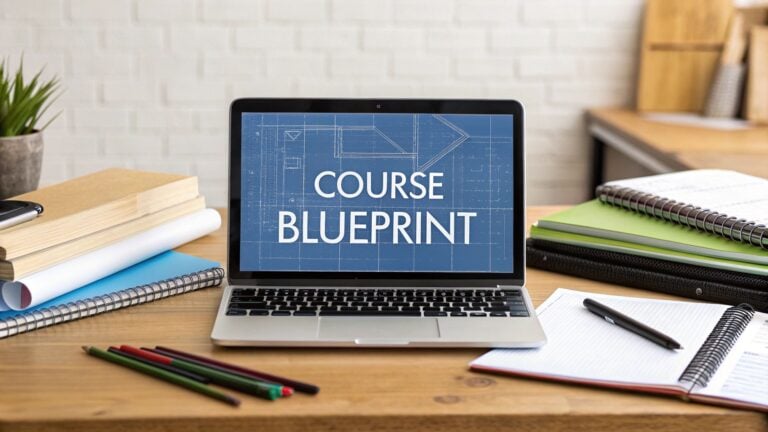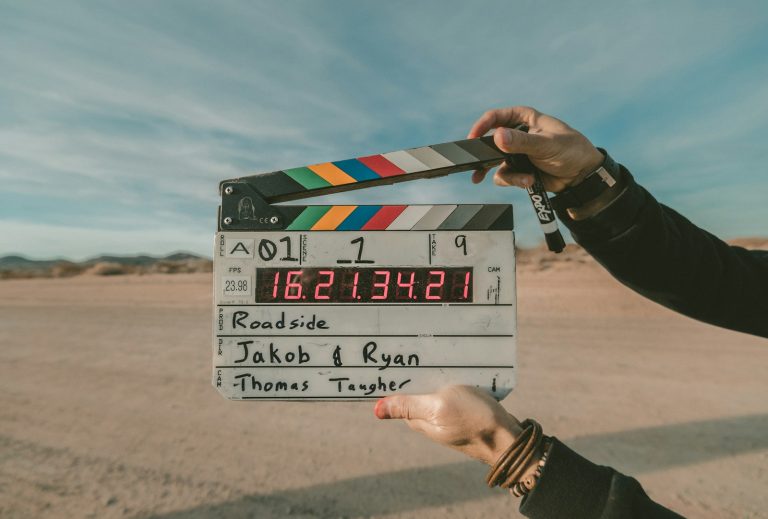How to Create a Curriculum From Scratch

To create a curriculum that works, you need more than a list of topics. You need a clear, structured plan. This involves starting with a deep analysis of who you’re teaching, defining exactly what they’ll be able to do afterward, sequencing the content logically, and then building the actual materials and tests.
Think of it as drawing a map before starting a long journey. You wouldn’t just start driving, right?
Your Foundation for an Effective Curriculum
Building a curriculum is about creating a thoughtful journey for your learners. It’s not just about dumping everything you know into a document.
I remember my first attempt at this. I just made a huge list of everything I thought was important, and frankly, it was a mess. The real success came when I learned to start with a clear destination in mind, a specific transformation for the student.
This first part is all about setting that solid foundation. A good curriculum is a dynamic roadmap, not a static syllabus. It’s designed to guide learners from where they are to where they need to be.
Shift Your Mindset From ‘What’ to ‘Why’
The most critical first step, before you even think about a single lesson, is to understand your purpose. Why are you creating this curriculum? What transformation do you want to provide?
Answering this is your strategic blueprint. It’s the philosophy that will guide every single decision you make from here on out.
The real goal is to empower your learners with new skills, perspectives, and capabilities that they can apply in the real world.
Thinking about the “why” forces you to focus on the end result first.
This perspective makes the entire process so much more focused and effective. It’s the best way to avoid creating content that, while interesting, doesn’t actually help learners achieve their goals.
The Evolution of Curriculum Design
The idea of a structured curriculum isn’t new, but it has changed a lot. Historically, curriculum design was about aligning education with what society needed.
A major milestone was the Tyler Rationale in 1949, which introduced a systematic four-step approach:
- Defining objectives
- Selecting experiences
- Organizing instruction
- Evaluating the results.
This framework helped formalize a process that many educators still find useful today.
However, modern curriculum development goes a step further by placing a heavy emphasis on the learner. Before you start writing content, it’s essential to grasp these core pillars.
Here’s a quick breakdown of what makes a modern curriculum truly effective:
The Core Pillars of Modern Curriculum Design
| Pillar | What It Means | Why It Matters |
|---|---|---|
| Learner-Centric Focus | Everything revolves around the student’s needs, prior knowledge, and goals. | Ensures relevance and engagement, leading to better outcomes. |
| Actionable Objectives | Moving from vague goals to specific skills (e.g., from “understand” to “build”). | Provides clear targets for learners and makes success measurable. |
| Engaging Content | Using a mix of formats like video, interactive quizzes, and projects. | Keeps learners motivated and caters to different learning styles. |
| Real-World Application | Connecting concepts to practical scenarios and hands-on activities. | Bridges the gap between knowing and doing, making skills stick. |
| Continuous Feedback | Integrating assessments and feedback loops throughout the learning process. | Allows for course correction and reinforces learning in real-time. |
These pillars represent a fundamental shift in how we think about teaching and learning. Adopting this learner-centric approach starts with one crucial action: conducting a needs analysis to understand exactly who you’re teaching.
If you’re looking for a great starting point, our training needs assessment template can provide a solid framework. This ensures you’re building a curriculum on a solid foundation of real learner data, not just your own assumptions.
Understand Exactly Who You Are Teaching
You can’t build a curriculum in a vacuum.
Before you write a single lesson or design one handout, you absolutely have to get inside the heads of your future learners. This involves basic empathy and real-world understanding, not some overly complex market research project.
The entire process of creating a curriculum that actually works hinges on this first step. If you don’t know your audience, you’re just guessing.
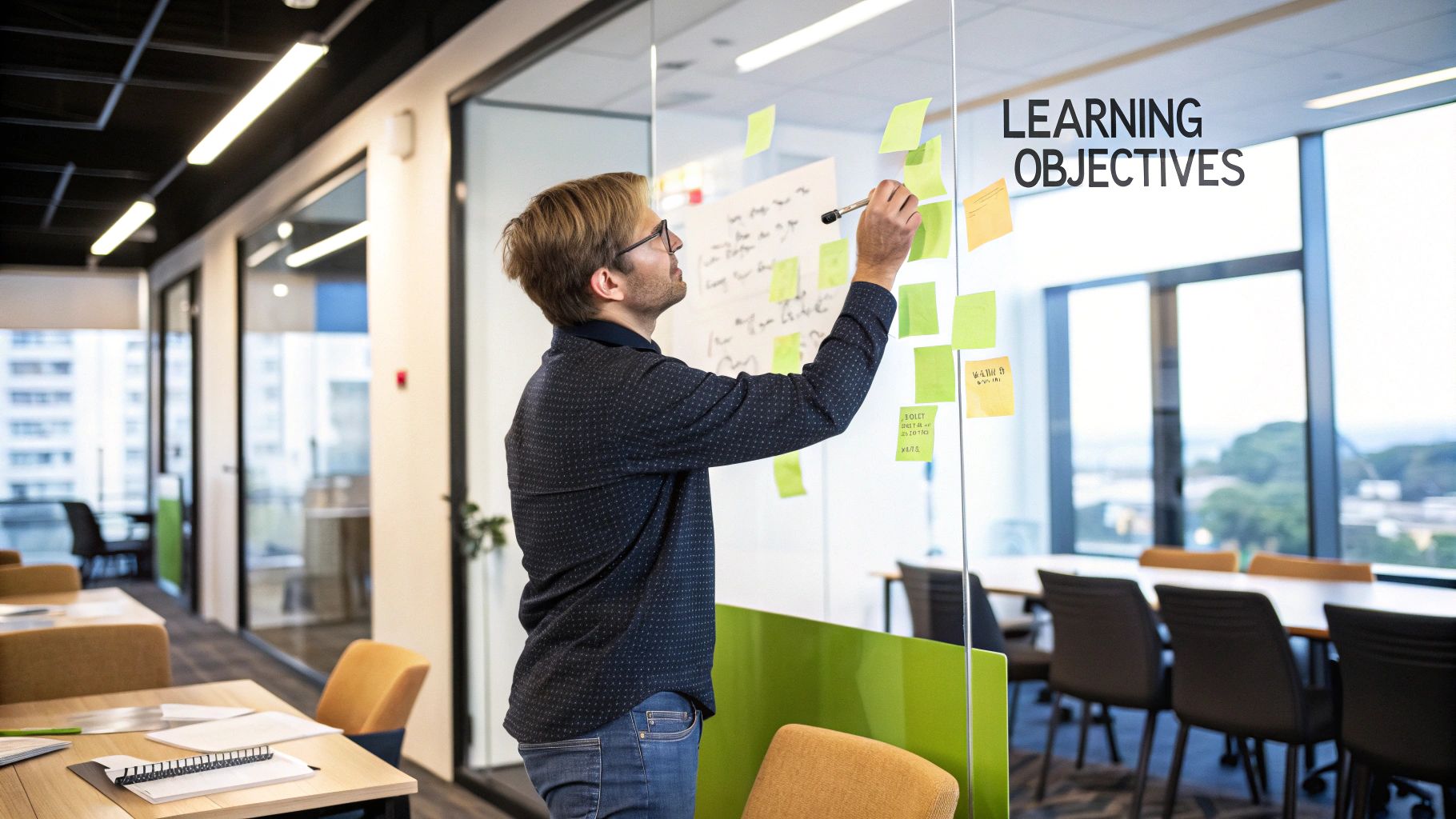
This initial investigation is often called a needs analysis. It’s the moment you shift from having a good idea to having a targeted, effective plan. It’s all about discovering what your learners already know, what they think they know, and what they desperately want to achieve.
Go Beyond Basic Demographics
It’s easy to define an audience by their age or job title, but that’s only scratching the surface. To build something that truly resonates, you need to dig much deeper. The goal here is to create a detailed learner persona, a fictional character that brings your ideal student to life.
Here are a few practical, no-nonsense ways to gather these crucial insights:
- Simple Surveys: Use a free tool like Google Forms to ask direct questions. Get straight to their pain points. Ask something like, “What’s the single biggest challenge you face when trying to learn photography?”
- Informal Interviews: Hop on a quick 15-minute chat with a handful of people in your target audience. Ask open-ended questions that encourage stories, like, “Tell me about the last time you tried to solve this problem. What happened?”
- Community Observation: Go hang out where your audience lives online. This could be specific Reddit threads, Facebook groups, or niche forums. Pay close attention to the questions they ask over and over. These are pure content goldmines.
This deep dive is a proven strategy with massive impact. The Global Partnership for Education helped over 372 million children by redesigning curricula to fit diverse local needs.
This focus on relevance led to nearly 10 million more children enrolling in school. You can see more about how they tailored learning in their education data highlights.
A Real-World Example: Beginner Photographers
Let’s say you’re building a course for aspiring photographers. The lazy approach would be to just list out technical topics like aperture, shutter speed, and ISO. But a real needs analysis gives you so much more to work with.
Your research might reveal that your audience:
- Feels overwhelmed by the buttons and dials on their new camera.
- Doesn’t understand why their photos are always blurry or too dark.
- Gets frustrated trying to take good pictures of their kids, who never sit still.
- Lacks the confidence to share their work because they don’t even know what “good” composition looks like.
This information is a total game-changer. It tells you that your curriculum should start by solving their most immediate and frustrating problems first.
Armed with these insights, you can structure your curriculum to deliver quick wins, building their confidence right from the get-go.
This leads to a much more powerful and effective plan:
| Vague Topic | Learner-Focused Module | What It Actually Teaches |
|---|---|---|
| Camera Basics | Your First 5 Shots Without Fear | How to use one key automatic mode to take clear, bright photos right away. |
| Composition Rules | Making Your Photos Look Amazing | Simple framing tricks like the rule of thirds to instantly improve photos of people and places. |
| Lighting | Stop Taking Dark, Blurry Photos | How to find and use the natural light in your home to get stunning results without fancy gear. |
See the difference? The first column is just a list of facts. The second column is a journey that speaks directly to the learner’s real-world struggles and goals.
When you truly understand who you are teaching, you can create a curriculum that feels like it was made just for them. That personal connection is what makes learning stick and turns your students into your biggest fans.
Define Clear and Actionable Learning Objectives
Once you’ve got a solid handle on who you’re teaching, it’s time to get brutally honest about what you want them to do when it’s all over. This is where we nail down your learning objectives. Think of them as the promises you make to your learners. When this course is finished, what will they be able to do, exactly?
This sounds simple, but it’s the point where a lot of curriculum plans start to go off the rails. It’s dangerously easy to write a vague goal like “students will understand marketing.” What does “understand” even look like? How do you measure it? You can’t.
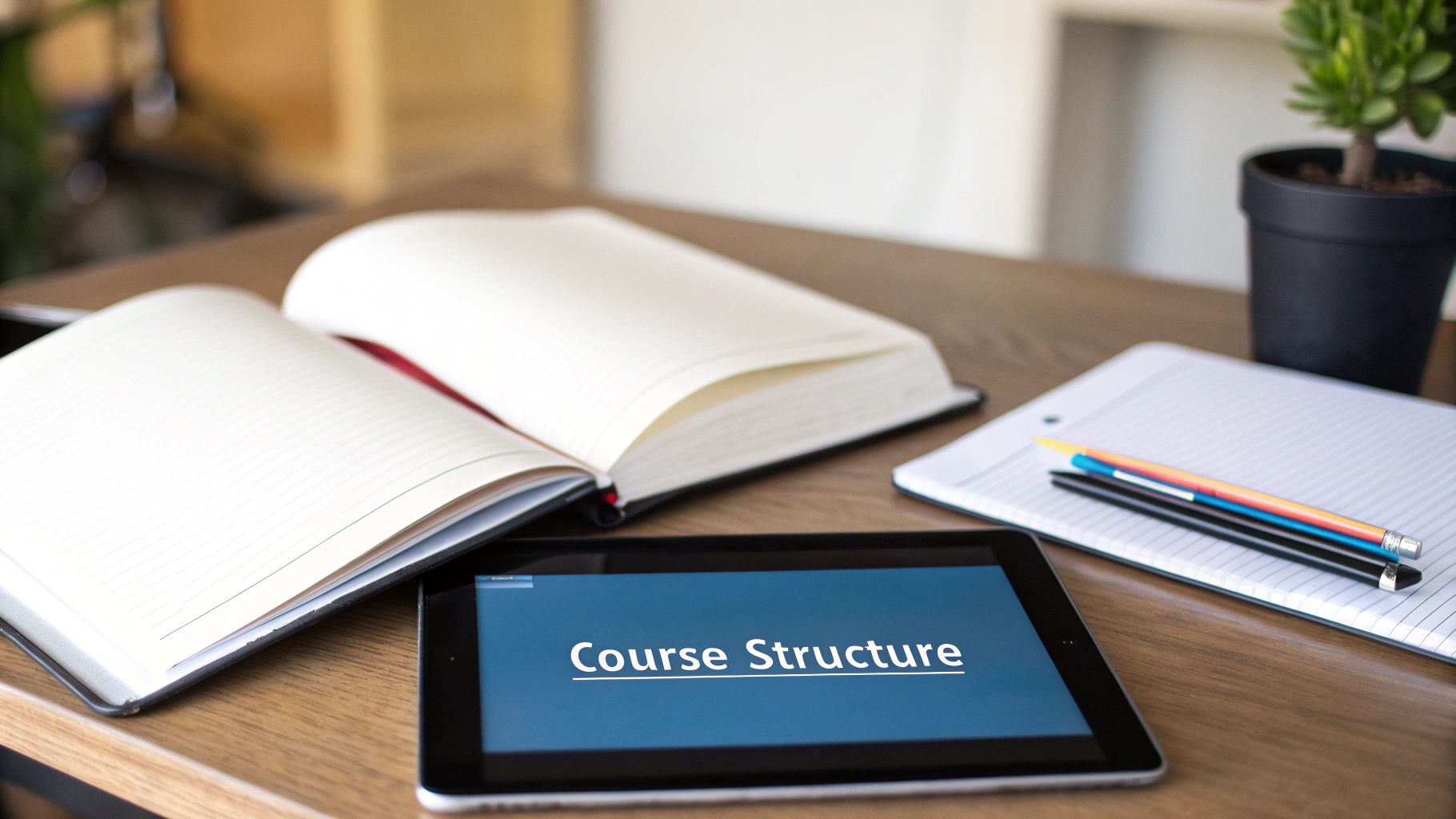
We need objectives that are specific, measurable, and action-oriented. Getting this clarity is your best friend. It will guide every single piece of content you create and make designing your final assessments almost effortless.
From Vague Ideas to Concrete Actions
To write powerful objectives, you need to lean on strong action verbs. This is where frameworks like Bloom’s Taxonomy come in handy, but don’t feel like you need to get lost in academic theory. The core idea is simple. Think about the level of thinking you expect from your learners.
Are you just asking them to recall a fact? Or do you want them to analyze, evaluate, or even create something new?
The difference between a passive goal and an active objective is everything. One describes a state of being, while the other describes a demonstrated skill. This shift is essential when you’re learning how to create a curriculum that delivers real results.
For instance, “Learn about social media” is a passive, fuzzy goal.
A much stronger, action-oriented objective is: “Create a 30-day social media content calendar for a small business.”
See the difference? The second one is a tangible skill someone can actually perform. It gives you a clear target to teach toward and a clear way to see if they’ve hit it.
Building Your Objectives with Action Verbs
Using the right verb is the fastest way to sharpen your objectives. Ditch weak, fuzzy verbs like “know,” “learn,” or “understand.” Instead, choose words that describe an action you can actually see and measure.
Here’s a quick list to get you started, broken down by the level of thinking involved:
- For Remembering: Define, list, recall, name, repeat.
- For Understanding: Classify, describe, discuss, explain, identify.
- For Applying: Implement, solve, use, demonstrate, prepare.
- For Analyzing: Differentiate, organize, compare, examine, test.
- For Evaluating: Appraise, defend, justify, critique, recommend.
- For Creating: Design, assemble, construct, develop, formulate.
Picking a verb from a higher level, like “design” or “critique,” naturally pushes you to create a more advanced and engaging learning experience. It forces the learner to move beyond simple memorization and into true application.
Real-World Examples of Strong Objectives
Let’s put this into practice. Imagine you’re building a curriculum for a few different fields. The structure of a good objective stays the same, no matter the topic.
Here’s how you can transform those vague goals into powerful learning objectives:
| Vague Goal | Strong Learning Objective | Why It Works |
|---|---|---|
| Learn to code | “Write a Python script that scrapes data from a website and saves it to a CSV file.” | It’s a specific, testable task that proves a core coding skill. |
| Be a better leader | “Deliver a 10-minute feedback session to a team member using the STAR method.” | It focuses on a practical, repeatable leadership action that can be observed. |
| Know about copywriting | “Compose three unique email subject lines designed to increase open rates for an e-commerce brand.” | It targets a clear business outcome and a specific creative skill. |
When I first started creating courses, I made the mistake of keeping my objectives way too broad. I figured “learn photography” was a good enough starting point. I quickly learned that my students felt lost because they had no clear milestones to aim for.
Now, I break that down into objectives like, “Adjust aperture and shutter speed in manual mode to properly expose a portrait.” It’s a specific skill they can practice, master, and feel a real sense of accomplishment from. This clarity is what keeps learners motivated and on track.
Start with action, and you’ll build a curriculum that truly empowers people.
Structure Your Curriculum for a Natural Flow
Alright, you’ve figured out who you’re teaching and what they need to achieve. Now for the fun part: drawing the map. This is where we lay out the journey that takes your learners from where they are today to the confident, capable person they want to become.
Think of it like this: a jumbled, disorganized curriculum is one of the fastest ways to lose someone. If lessons feel random and disconnected, students get confused, frustrated, and quickly lose motivation.
Your goal here is to create a seamless path where each lesson logically builds on the one before it, creating a powerful sense of momentum that keeps them hooked.
When I was first building courses, my go-to tool was a giant whiteboard and a pack of sticky notes. I’d throw all my ideas up there and then spend hours physically moving the notes around until the flow just felt right.
These days, I often use digital tools like Miro or Trello to do the same thing, but the core process is identical. The tool doesn’t matter. What matters is visually organizing your ideas into a sequence that makes sense.
Choose a Structure That Makes Sense
There’s no one-size-fits-all answer here. The best structure for your curriculum depends entirely on your topic and what your learners need.
You’re looking for the model that creates the smoothest, most intuitive journey from point A to point B.
Here are a few of the most common and effective models I’ve used over the years:
- Simple to Complex: This is the classic approach. You start with the absolute basics, the foundational concepts, and gradually layer on more advanced ideas. It’s perfect for technical subjects like coding, math, or learning a musical instrument. You have to learn the scales before you can play a symphony.
- Chronological Flow: This one’s pretty straightforward. You organize the content along a timeline. It’s the obvious choice for a history course, but it’s also fantastic for teaching any process that has a clear beginning, middle, and end, like planning a wedding or launching a product.
- Project-Based Structure: This is one of my personal favorites for driving motivation. You frame the entire curriculum around completing a central, meaningful project. Each lesson or module teaches a specific skill needed to complete the next stage of that project. It’s incredibly powerful because learners are actively building something tangible from day one.
For example, a course on digital marketing could be structured around building a complete marketing plan for a fictional (or even their own) business.
Week one could be defining a target audience, week two would be setting up social media profiles, and so on.
Break Big Topics into Bite-Sized Pieces
Once you have that high-level structure in place, it’s time to get granular. You need to take those big, intimidating topics and slice them into manageable modules, lessons, and activities.
This process not only makes the content feel less overwhelming for the learner, but it also makes it much easier for you to create.
A great outline is the absolute backbone of your course. If you need some help getting started, you can find a fantastic free course outline template that will help you organize your thoughts and build out your content logically.
This process of breaking things down is a core principle of instructional design. The classic ADDIE model works beautifully. It moves from high-level analysis all the way down to detailed development and evaluation, with each phase flowing logically into the next.
A well-paced curriculum respects the learner’s time and cognitive load. Rushing through complex topics or spending too much time on simple ones can both lead to disengagement.
Think about the natural rhythm of learning.
People need moments of direct instruction, followed by chances to practice what they’ve learned, and then time to reflect and get feedback. This is exactly where you should plan for different types of assessments to check for understanding along the way.
By building in smaller checks for understanding, you create a continuous feedback loop that improves the entire learning experience for you and your students.
Develop Engaging Content and Meaningful Assessments
You’ve got your map and you know your destination. Now it’s time to actually build the path.
But creating content and assessments is so much more than just dumping what you know into a document or hitting “record” on a few videos. The real magic is in designing an active, hands-on experience for your learners.
You need to always match your content type directly to your learning objective. If your goal is for someone to “analyze data,” a simple reading assignment just won’t cut it. They need a real dataset to actually dig into.

Making Learning Active, Not Passive
Passive learning, like just watching a lecture, leads to notoriously low retention. It’s active learning, where students are doing something, that makes new skills and knowledge actually stick. Your job is to brainstorm a variety of content formats that force learners to engage.
Think beyond the standard lecture. Here are a few ideas to mix things up:
- Interactive Videos: Instead of a simple talking head, embed questions directly into your videos. If you need some pointers, we have a complete guide on how to create engaging online course videos that will get you started.
- Hands-on Projects: Give learners a real project to build throughout the course. This could be anything from writing a business plan to coding a small application or creating a piece of art.
- Group Assignments: Encourage collaboration by having learners work together on case studies or presentations. This builds crucial communication and teamwork skills right alongside the subject matter.
- Simulations and Scenarios: Create “what would you do?” scenarios that force learners to apply their knowledge to a realistic situation and make decisions under pressure.
You’re trying to create a dynamic mix. A module might start with a short video explaining a concept, then flow into a hands-on activity where students practice it, and finish with a group discussion to share their findings. This variety keeps things interesting and plays to different learning preferences.
Moving Beyond the Multiple-Choice Test
How do you know if your students are actually learning? This is where assessment comes in, and I really want to encourage you to think far beyond the traditional multiple-choice quiz.
Quizzes are great for checking basic knowledge recall, but they don’t tell you if a learner can apply that knowledge in the real world. That’s why I’m a huge fan of authentic assessments.
Authentic assessments are tasks that mirror what a professional would actually do in their field. They measure a learner’s ability to use their skills in a practical, meaningful context.
This approach is so much more valuable for both you and the learner. You get a true measure of their competence, and they get a piece of work they can be proud of, often something they can add to a portfolio.
Designing Assessments That Actually Mean Something
When you’re mapping out your curriculum, weave your assessments right into the learning process. They shouldn’t feel like a surprise pop quiz at the end. Instead, they should feel like a natural extension of the learning activities themselves.
Here’s how you can shift your thinking from traditional tests to more meaningful, authentic assessments:
| Traditional Assessment | Authentic Assessment Alternative | What It Measures |
|---|---|---|
| A multiple-choice test on marketing terms. | Develop a one-page marketing proposal for a local business. | Ability to apply marketing concepts to a real-world problem. |
| An essay about leadership theories. | Record a short video delivering constructive feedback to a team member. | Practical communication and leadership skills in action. |
| A quiz on historical dates. | Create an annotated timeline of an event, explaining cause and effect. | The ability to analyze historical information, not just memorize it. |
These types of assessments give your learners valuable experience. They are actively practicing the very skills you promised they would learn, not just proving what they know. This approach transforms assessment from a stressful test into an empowering part of the educational journey.
Use Data to Make Your Curriculum Even Better
You’ve designed your learning objectives, structured your content, and built your assessments. You might think the hard work is over, but there’s one more crucial piece to the puzzle. The best curriculums aren’t static documents. They’re living, breathing resources that evolve over time.
This final stage is all about review and iteration. It’s how you take a good curriculum and make it truly great by paying attention to what your learners and the data are telling you.
How to Gather Feedback That Actually Helps
The first step is collecting feedback, but you have to be smart about it. Asking a vague question like, “Did you enjoy the course?” won’t get you anywhere. You need specific, targeted insights that point directly to what you can improve.
Here are a few ways I’ve found to get feedback that’s pure gold:
- Simple Feedback Surveys: At the end of a module or the entire course, pop in a short survey. Don’t ask too many questions. Focus on the important stuff like, “Which lesson was the most confusing and why?” or “What was the single most valuable activity you completed?” This gets you actionable answers.
- Pilot Programs: Before you launch to a wide audience, run a small pilot program with a handful of learners. The feedback from this initial group is invaluable. You can work with them closely, see exactly where they get stuck, and iron out the kinks before a full-scale launch.
A classic mistake is to blame the student when they struggle. If a huge chunk of your learners are bombing a specific quiz, the problem is almost certainly how you presented the material, not them.
This feedback is a roadmap showing you exactly where the weak spots are, giving you a clear path for what to fix.
Using Data to Find the Weak Spots
Beyond what people tell you directly, performance data tells a powerful story. You need to look at quiz scores, assignment completion rates, and especially where students drop off. These numbers are clues that shine a spotlight on areas needing your attention.
For example, if you see that 75% of students stop watching a particular video halfway through, that’s a huge red flag.
It’s a clear sign that the content might be dragging, getting confusing, or just isn’t engaging at that point. You can then re-record that section, break it up, or add a downloadable guide to clarify things.
Major organizations do this process on a massive scale. UNESCO’s Institute for Statistics, for instance, constantly uses new data from 76 countries to refine educational approaches. This data-driven cycle helps them make precise adjustments to ensure curriculums are actually hitting their goals.
You can apply the very same principle, just on a smaller scale.
The goal is to build a continuous improvement cycle. This loop of teaching, assessing, gathering feedback, and refining is what separates a static, outdated curriculum from one that truly serves its learners.
When you embrace this process, you ensure your curriculum stays relevant, effective, and gets better with every new group of students that comes through.
Frequently Asked Questions
I’ve put together some of the most common ones here. Hopefully, these answers can shed some light on any questions you might have.

So, How Long Does It Take to Create a Curriculum?
That’s the million-dollar question, isn’t it? And honestly, there’s no single, satisfying answer. The timeline depends entirely on the scope and complexity of your project.
For instance, pulling together a curriculum for a simple one-day workshop might only take a week or two of focused work. But if you’re building a full, semester-long university course from scratch, you could easily be looking at several months of development.
Stop watching the clock and start focusing on the process. A thorough needs analysis and a set of crystal-clear learning objectives will save you an unbelievable amount of time down the road.
What’s the Biggest Mistake People Make?
The most common trap I see people fall into is jumping straight into content creation before they truly understand their audience and what those learners actually need to achieve.
It’s so easy to get excited and just start building PowerPoint slides or recording videos packed with everything you know.
But that approach almost always creates a curriculum that feels unfocused. It might be loaded with fantastic information, but if it doesn’t solve the learner’s real-world problems, it’s missed the mark.
Always, always start with the ‘who’ (your audience) and the ‘what’ (their desired outcomes) before you even think about the ‘how’ (your content). This simple rule is the key to creating a curriculum that makes a real impact.
Do I Really Need Special Software to Design a Curriculum?
Absolutely not! You don’t need to go out and buy fancy, expensive software to get started. In fact, some of the best curriculums I’ve seen were first mapped out with simple, everyday tools.
You can outline an entire course effectively with things you probably already have on your computer.
- For outlining: A simple Google Doc or Word document is perfect for mapping out modules and lessons.
- For organizing: A digital whiteboard like Miro or a project board like Trello can help you visualize the flow and move pieces around.
- For visuals: A free tool like Canva is more than enough for creating simple graphics or handouts.
The quality of your curriculum comes from the depth of your planning and the clarity of your thinking, not the software you use.



